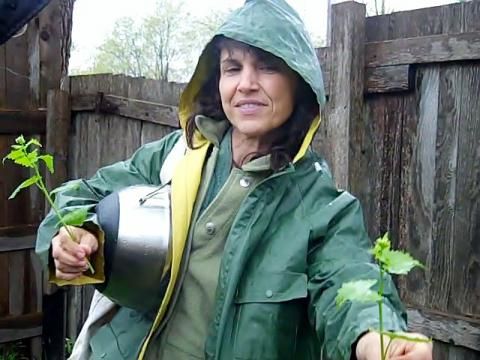
Marguerite Uhlmann-Bower leads a "weed walk" in Bloomville earlier this month. Photo by Lillian Browne.
We're delighted to introduce Lillian Browne, a new Watershed Post contributor. Browne is a farmer, writer and self-described adventure seeker who lives with her husband and three daughters in Walton where, she says, she "is continually inspired by nature, her horses and the opposing perspective." Browne covers town meetings for the Walton Reporter and pens a column, "Foible in the Fairytale," for the Delaware County Times. Browne sent us this article about an edible plants nature walk she attended in Bloomville earlier this month. -- Julia Reischel
Weeds were on the menu at the Turquoise Barn Bed and Breakfast in Bloomville a few Wednesdays ago. As part of a foraging workshop series called "Leaves, Weeds, Seeds and Shoots," 22 would-be hunter-gatherers sampled garlic mustard, dandelion leaf, burdock leaf, yellow dock and stinging nettles -- all weeds that you might find in your backyard.
Herbalist and registered nurse Marguerite Uhlmann-Bower and Turquoise Barn owner Michelle Premura hosted the “weed walk” on May 4. The foods fit right in with Premura's regular menu -- she regularly prepares vegan and vegetarian meals for her bed and breakfast guests that feature wild-harvested foods. Two of her specialties are stinging nettle crackers and smoothies.
As the leader of the walk, Bower was quick to remind people not to over-harvest wild edibles. Encouraging people to “think long term" and to "keep sustainability in mind,” she also pointed out that “'natural' is not synonymous with 'safe.' Natural also does not mean that ‘more is better.’”
Garlic mustard, an invasive species which grows abundantly in the Catskills, was one of Bower's recommended plant delicacies. She explained that it is a tender spring plant that is very edible and quite flavorful in salads. Garlic mustard resembles ground ivy, which is not edible, so it's important to be sure of its identity before eating it. Ground ivy, she explained, eventually blooms with little purple flowers. Garlic mustard has white flowers and, as its name implies, its leaves smell like garlic when crushed. Mature garlic mustard plants have white blossoms on long spikes.
Bower pointed out that dandelion is another easy-to-find edible weed. Very high in vitamin A, dandelion can be eaten or taken medicinally as a diuretic. (Bower strongly cautioned that any substance being consumed for medicinal purposes be discussed with a health care provider, and noted that herbal preparations could interfere with prescribed medications or an existing medical condition.)
The bitter raw leaves of dandelion can be tasty in soups, salads, quiches and stews, Bower said. She also provided a few recipes for other parts of the dandelion, including the flowers, which can be made into dandelion wine, and the roots, which can be made into a substitute for coffee.
For those interested in harvesting a few weeds for lunch, Bower had some advice. She suggested not harvesting plants near roadsides, as they may become contaminated with salt, brake dust or other pollutants.
“We are what we eat,” Bower said.
Bower has scheduled several additional “weed walks” for this summer at other Delaware County businesses. On July 6th, she'll lead a walk at Pepacton Natural Foods in Downsville. On August 3rd, she'll return to the Turquoise Barn in Bloomville. On September 7th, she will appear at Harmony Hill Retreat Center in East Meredith. On October 5th, she'll be at Masonville General Store in Masonville. There is a $15.00 cost for each walk, which covers hands-on instruction and identification of seasonal herbs and plants as well as instruction in preparation of wild edibles. A portion of the proceeds for the walks are being used to support Chenango Delaware Otsego Gas Drilling Opposition Group (CDOG). For more information or to sign up contact Marguerite Uhlmann-Bower at 607-278-9635.













